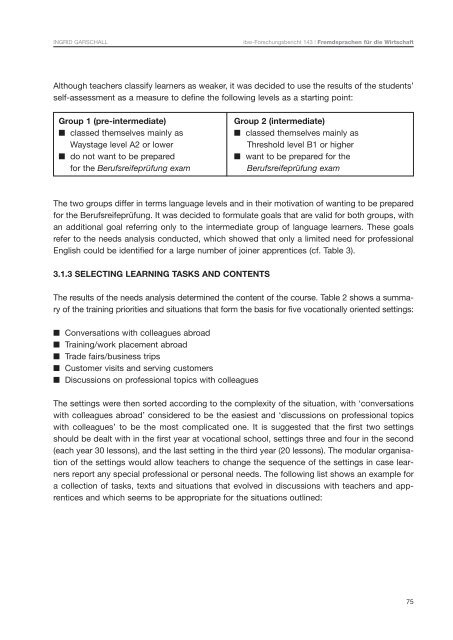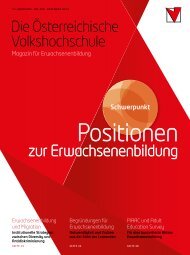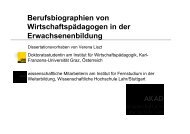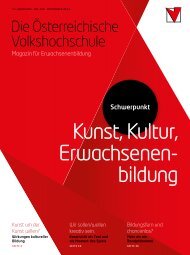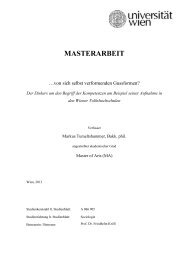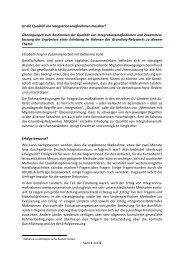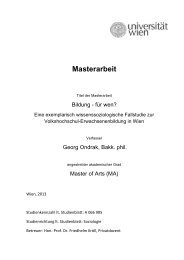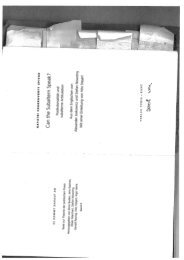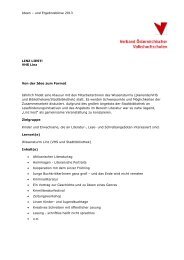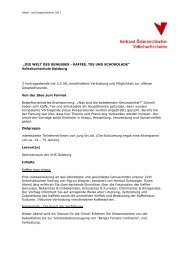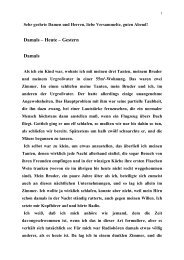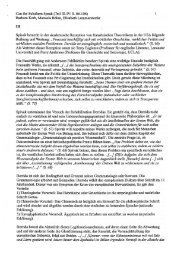Der sichere Umgang mit fremden Sprachen und Kulturen stellt heute ...
Der sichere Umgang mit fremden Sprachen und Kulturen stellt heute ...
Der sichere Umgang mit fremden Sprachen und Kulturen stellt heute ...
Sie wollen auch ein ePaper? Erhöhen Sie die Reichweite Ihrer Titel.
YUMPU macht aus Druck-PDFs automatisch weboptimierte ePaper, die Google liebt.
INGRID GARSCHALL ibw-Forschungsbericht 143 | Fremdsprachen für die Wirtschaft<br />
Although teachers classify learners as weaker, it was decided to use the results of the students’<br />
self-assessment as a measure to define the following levels as a starting point:<br />
Group 1 (pre-intermediate) Group 2 (intermediate)<br />
■ classed themselves mainly as ■ classed themselves mainly as<br />
Waystage level A2 or lower Threshold level B1 or higher<br />
■ do not want to be prepared ■ want to be prepared for the<br />
for the Berufsreifeprüfung exam Berufsreifeprüfung exam<br />
The two groups differ in terms language levels and in their motivation of wanting to be prepared<br />
for the Berufsreifeprüfung. It was decided to formulate goals that are valid for both groups, with<br />
an additional goal referring only to the intermediate group of language learners. These goals<br />
refer to the needs analysis conducted, which showed that only a li<strong>mit</strong>ed need for professional<br />
English could be identified for a large number of joiner apprentices (cf. Table 3).<br />
3.1.3 SELECTING LEARNING TASKS AND CONTENTS<br />
The results of the needs analysis determined the content of the course. Table 2 shows a summary<br />
of the training priorities and situations that form the basis for five vocationally oriented settings:<br />
■ Conversations with colleagues abroad<br />
■ Training/work placement abroad<br />
■ Trade fairs/business trips<br />
■ Customer visits and serving customers<br />
■ Discussions on professional topics with colleagues<br />
The settings were then sorted according to the complexity of the situation, with ‘conversations<br />
with colleagues abroad’ considered to be the easiest and ‘discussions on professional topics<br />
with colleagues’ to be the most complicated one. It is suggested that the first two settings<br />
should be dealt with in the first year at vocational school, settings three and four in the second<br />
(each year 30 lessons), and the last setting in the third year (20 lessons). The modular organisation<br />
of the settings would allow teachers to change the sequence of the settings in case learners<br />
report any special professional or personal needs. The following list shows an example for<br />
a collection of tasks, texts and situations that evolved in discussions with teachers and apprentices<br />
and which seems to be appropriate for the situations outlined:<br />
75


